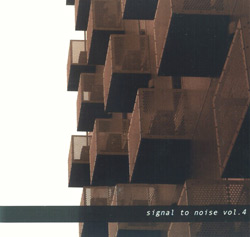
The fourth volume in Günter Müller's ongoing series of electroacoustic improv "supergroup" meetings finds his lineup expanding two-fold; more's apparently the merrier. Bear in mind, however, that with this sextet of Müller, Jason Kahn, Tomas Korber, Norbert Moslang, Christian Weber, and Katsura Yamauchi, the enlarged Signal to Noise collective (which might well be the project name rather than a formal group, though it's a semantic point of little consequence) hardly muddies up the soundfield. On the contrary, housing together these six fertile minds and their trusty equipment in the same room if anything breeds not a more engulfing aural spectrum but rather a spirited, carefully textured one. This is, of course, music made from probe and gesture, touch and circumstance, splash and patter, fingers bending circuitry with the same concentrated poise as when plying the tactile characteristics of their acoustic cousins.
Of said acoustics, bassist Weber and sax "player" (or should one say "ionizer"?) Yamauchi — and probably Kahn as well, who strikes various surfaces in addition to massaging keys on a synth — find themselves merely two further elements in a simmering digitized stew. Through two lengthy tracks, sounds curdle, crackle, fizz, coalesce, pop, and hiss, as if the sextet is actualizing the post-coital wheezes of exhausted heating devices. Played at volumes high enough to shove out any outside influences, the group agitates their sundry electronic noisemakers in the service of a materialized "anti"-industrial music, flensed-out doppelganger quirks of what might emanate from between your house's floorboards and foundation. Who does what is largely irrelevant — Korber's guitar spikes, when noticeable, spread tenacious bits of gristle into the overall electrified throb; Yamauchi's honks act like simian mating calls in the wilderness; Kahn's exclamatory percussive thwacks mimic those PC error tones that erupt when keys are pressed by mistake. No discernible beginning, middle or end ever announces itself — from the outset, the ear is thrust into this microcosmic whorl of sound, proof that the music, "acoustically" generated rather than programmed, operates comfortably within it's pithy electronic framework, evolving at the kind of unhurried pace that reveals delicate shades of nuance spin after spin.
If there remains any difference between this edition and previous volumes in the series it is that Müller's crew has crossed that boundary wherein the players' instinctual interactions with one another border virtually on the telepathic. Simply dazzling aerobics for the ear.
Comments and Feedback:
|



